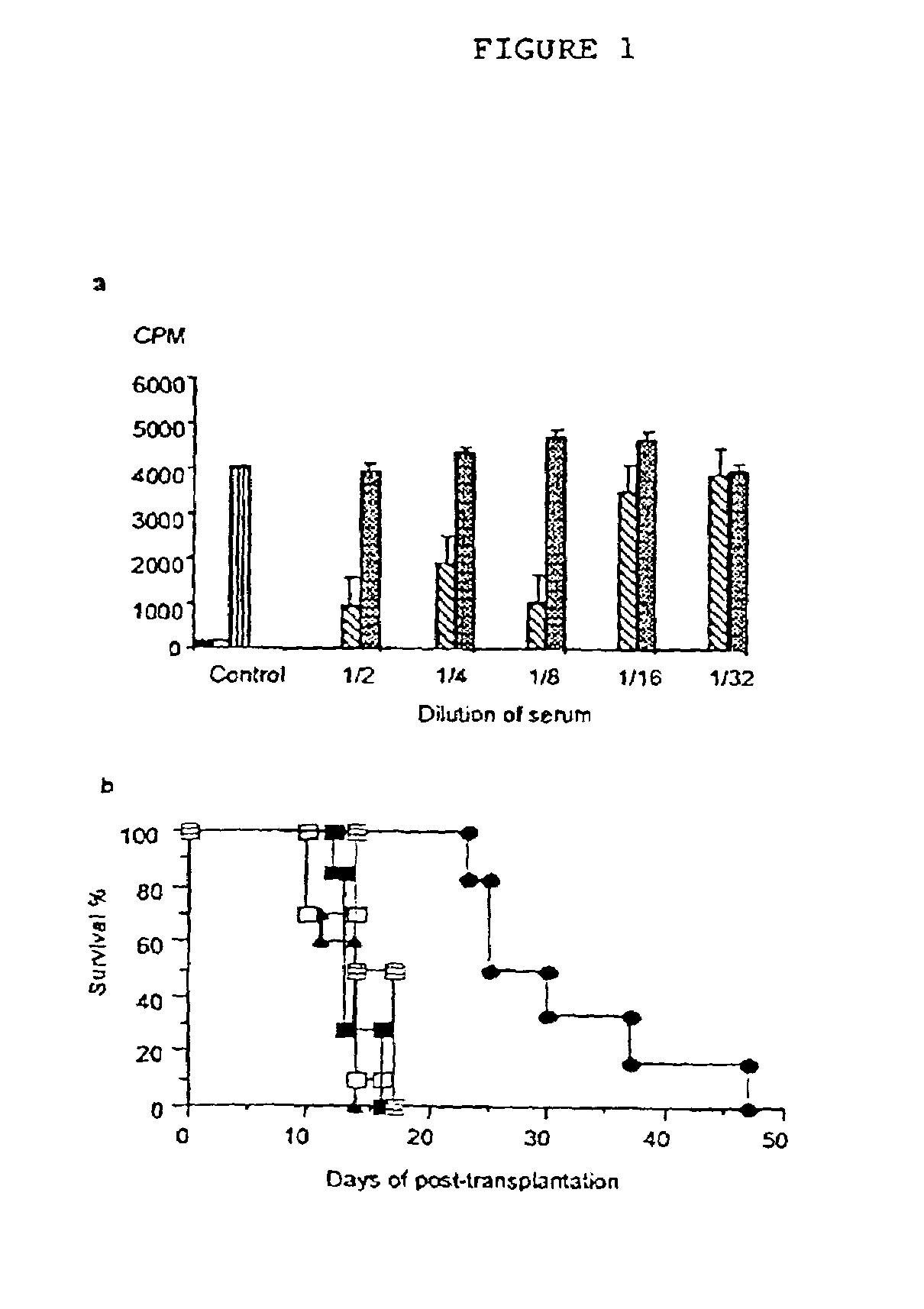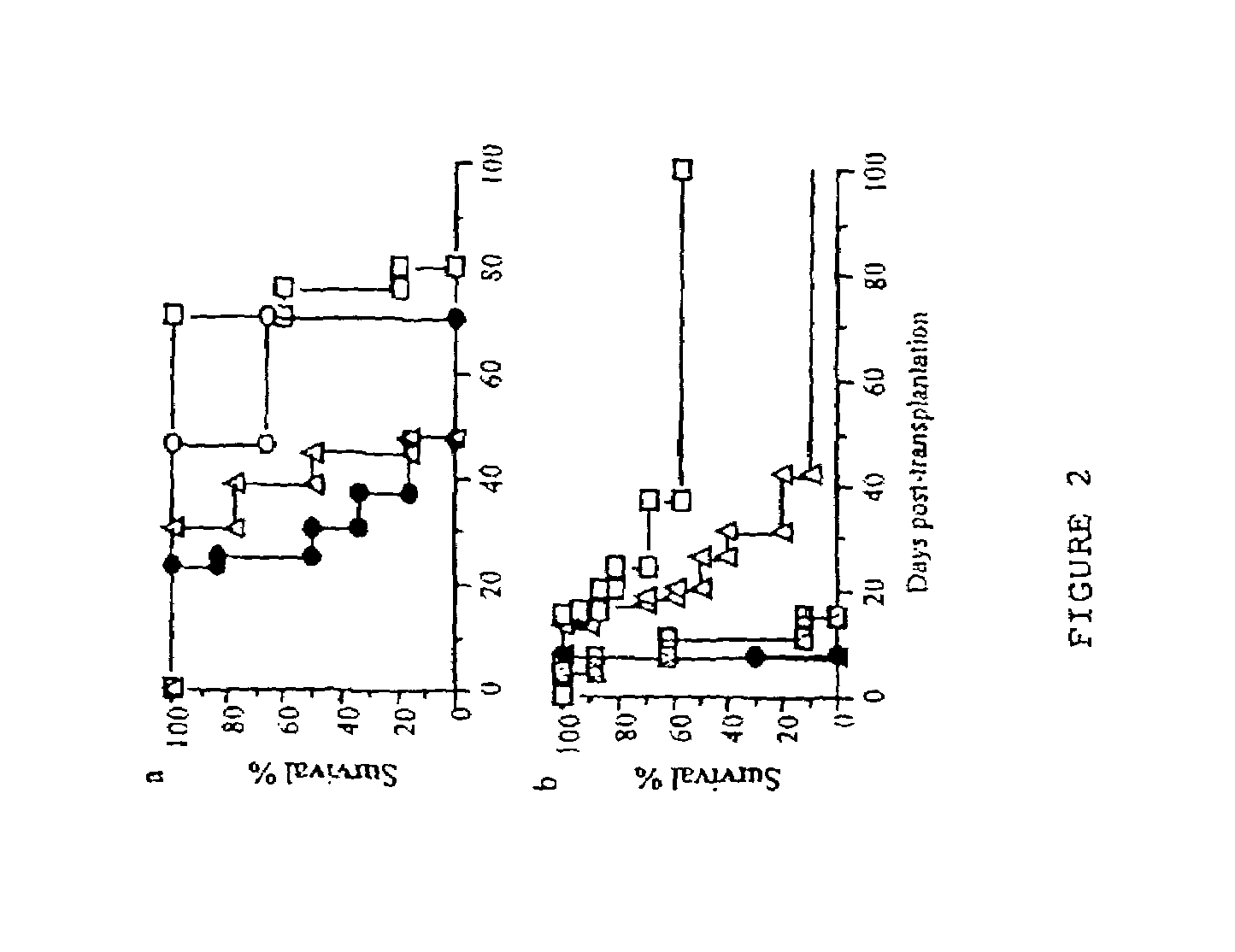Method of inducing immune tolerance
a technology of immune tolerance and immunoglobulin, which is applied in the field of induction of immune tolerance, can solve the problems of difficult to ascertain the number of recipients, the side effects of immunosuppressive therapy are considerable, and the recipients can become very susceptible to infection and malignancy
- Summary
- Abstract
- Description
- Claims
- Application Information
AI Technical Summary
Benefits of technology
Problems solved by technology
Method used
Image
Examples
example 1
Experimental Materials and Methods
Cloning of rat IL-5
[0073]Rat IL-5 was cloned and transfected into CHO-K1 cells, as described (11). IL-5 transfected CHO-K1 cells were cultured in DMEM-F12 medium (Gibco BRL), 10% FCS and a selection marker Hygromycin (Boehringer Mannheim, Mannheim, Germany). rIL-5 was collected as serum free cell culture supernatant and purified by the Flag fusion system (Scientific Imaging Systems, New Haven, Conn.). The purified rIL-5 was filtered (0.2 μm), aliquoted and stored at −70° C. rIL-5's biological activity was confirmed in vitro by its ability to support growth of B13 cells (Dr C Sanderson, Perth, Wash., Australia) as described (17). One unit was defined as the dilution required for 50% of maximum proliferation. Preparations had 0−<0.06 EU / ml of endotoxin (Limulus Amebocyte Lysate assay, Coatest Gel-LAL, Chromogenix AB, Moindal, Sweden).
Other Cytokines and Monoclonal Antibodies
[0074]Human rIL-2 (Boehringer Mannheim) was administered at 20,000 units per d...
example 2
Effect of IL-5 on Allograft Rejection
[0080]To examine the effects of IL-5 therapy on allograft responses DA rats were given 4000 units of recombinant rat IL-5 (rIL-5) by intra-peritoneal injection daily for 10 days, commencing on the day of transplantation of fully allogeneic PVG neonatal cardiac allografts. This treatment delayed rejection to 27 (23-47) days (median (range)), compared to normal rejection in untreated controls at 14 (10-14) days (p<0.001) and to controls treated with supernatant from non-transfected CHO-K1 cells 13 (10-15) days (p<0.001) (FIG. 1). This experiment was repeated five times with a similar significant delay in rejection. The combined results were 26 (16-49) (n=23) for rIL-5 treated compared to untreated controls 13.5 (10-15)(n=20)(p<0.0001). A ten-fold increase in dose of rIL-5 (40,000 units per day) had a similar effect, but a lower dose of 400 units per day did not delay rejection.
[0081]Co-administration of IL-5 with a monoclonal antibody (mAb) that bl...
example 3
Effect of IL-5 on Induction of Tolerance
[0082]To examine whether rIL-5 could enhance induction of tolerance to an allograft, this therapy was combined with anti-T cell mAb therapies that if given alone only serves to delay rejection. Anti-CD4 (MRC 0×38) mAb given to DA rats with PVG neonatal heart grafts delayed rejection to 25-44 days (FIG. 2a), and when combined with rIL-5 all the grafts survived over 70 days (pa).
[0083]The effect of rIL-5 in a heterotopic adult heart graft model was also examined, as indefinite graft survival can be induced without non-immunological graft loss. rIL-5 therapy alone had no effect on PVG adult allograft survival in “low responder” DA rats. As anti-T cell mAb therapy alone readily induces tolerance in the low responder DA model, we examined if rIL-5 could facilitate induction of tolerance in the “high responder” Lewis strain. In these rats anti-T cell mAb alone only delays rejection (12), and long term graft acceptance is rarely obtained without high...
PUM
| Property | Measurement | Unit |
|---|---|---|
| reactivity | aaaaa | aaaaa |
| DA | aaaaa | aaaaa |
| time | aaaaa | aaaaa |
Abstract
Description
Claims
Application Information
 Login to View More
Login to View More - R&D
- Intellectual Property
- Life Sciences
- Materials
- Tech Scout
- Unparalleled Data Quality
- Higher Quality Content
- 60% Fewer Hallucinations
Browse by: Latest US Patents, China's latest patents, Technical Efficacy Thesaurus, Application Domain, Technology Topic, Popular Technical Reports.
© 2025 PatSnap. All rights reserved.Legal|Privacy policy|Modern Slavery Act Transparency Statement|Sitemap|About US| Contact US: help@patsnap.com



